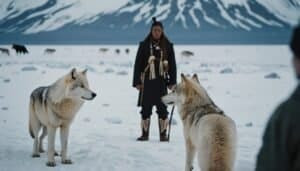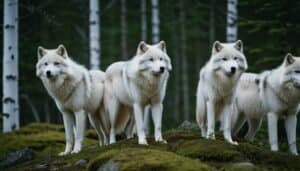Introduction
Indigenous communities play a pivotal role in the conservation of Arctic wolves, leveraging their traditional knowledge, cultural beliefs, and collaborative efforts with scientists
This article delves into the benefits of indigenous practices, successful conservation projects, the challenges faced, and the adaptive strategies employed. It also explores the supportive policies and long-term benefits of these efforts, along with the methods used by indigenous communities to monitor wolf populations
Indigenous Practices and Cultural Beliefs in Arctic Wolf Conservation
Indigenous communities have long coexisted with Arctic wolves, developing a profound understanding of their behaviors, habitats, and ecological significance. This deep-rooted connection shapes their conservation practices, blending traditional knowledge with spiritual beliefs and ethical considerations
Benefits of Indigenous Practices
Indigenous practices offer numerous benefits to Arctic wolf conservation. These communities possess intimate knowledge of the land and wildlife, accumulated over generations. This knowledge includes understanding the wolves’ migratory patterns, breeding habits, and prey preferences
Indigenous tracking techniques, often more accurate than modern methods, allow for better monitoring of wolf populations
Furthermore, indigenous practices emphasize sustainable living. By hunting selectively and respecting wildlife, these communities ensure the balance of ecosystems. Such practices prevent overhunting and help maintain the prey-predator equilibrium crucial for the survival of Arctic wolves
Traditional Knowledge Applied in Conservation
Traditional ecological knowledge (TEK) is invaluable in Arctic wolf conservation. TEK encompasses a wide range of practices, from seasonal hunting restrictions to habitat preservation
Indigenous communities, for example, know which areas are critical for wolf denning and avoid disturbing these sites during sensitive periods
Additionally, TEK helps in mitigating human-wildlife conflicts. Indigenous methods of deterring wolves from livestock or settlements are often non-lethal and effective. By using techniques such as creating buffer zones or employing guardian animals, indigenous communities reduce the likelihood of retaliatory killings of wolves
Spiritual Connections to Arctic Wolves
The spiritual connection between indigenous peoples and Arctic wolves plays a crucial role in conservation efforts. Many indigenous cultures regard wolves as sacred animals, embodying strength, loyalty, and resilience
These spiritual beliefs foster a deep respect for wolves, discouraging harmful practices and promoting protective measures
Ceremonies and rituals often include honoring the wolf spirit, which reinforces the cultural importance of conservation. By embedding respect for wolves in their spiritual and cultural practices, indigenous communities ensure that conservation efforts are not just ecological but also cultural imperatives
Indigenous Conservation Ethics
Indigenous conservation ethics are rooted in the principle of reciprocity—taking care of the land and its inhabitants in return for what they provide. This ethical framework guides the sustainable management of natural resources and wildlife
For instance, the practice of leaving parts of the hunted prey as an offering to the spirit of the animal ensures that hunting is conducted with gratitude and respect. This ethical approach minimizes waste and encourages sustainable hunting practices that do not deplete wolf populations
Indigenous communities also emphasize the importance of intergenerational knowledge transfer. Elders teach the younger generation about the significance of wolves and the best practices for coexisting with them
This ensures that traditional conservation methods are preserved and adapted to contemporary challenges
Collaboration and Success Stories in Conservation
Collaboration between indigenous communities and scientists has proven to be a powerful force in Arctic wolf conservation
By combining traditional ecological knowledge (TEK) with modern scientific methods, both groups can achieve more effective conservation outcomes. Several success stories highlight the benefits of such partnerships
Joint Conservation Projects
Joint conservation projects leverage the strengths of both indigenous knowledge and scientific expertise. One notable example is the establishment of co-managed protected areas
Indigenous communities often play a leading role in managing these areas, using their deep understanding of local ecosystems to inform conservation strategies. Scientists contribute by conducting research and providing data-driven insights to support these strategies
For instance, in some regions, indigenous and scientific teams work together to monitor wolf populations using a combination of traditional tracking methods and GPS collaring technology. This dual approach provides a comprehensive understanding of wolf behavior and movements, aiding in the development of targeted conservation measures
Knowledge Exchange Programs
Knowledge exchange programs facilitate the sharing of information and techniques between indigenous communities and scientists. These programs often involve workshops, fieldwork collaborations, and community meetings where both parties can learn from each other
Through these exchanges, scientists gain valuable insights into indigenous tracking and habitat management practices, while indigenous communities benefit from learning about new technologies and research findings. This mutual learning process enhances the overall effectiveness of conservation efforts and fosters a sense of partnership and respect
Case Studies of Success
There are numerous case studies showcasing the success of indigenous-led conservation initiatives
One such example is the Inuit-led wolf monitoring program in Nunavut, Canada. This program integrates traditional tracking methods with modern technology to monitor wolf populations and their prey. The data collected has been instrumental in informing management decisions and ensuring the sustainability of both wolf and prey populations
Another success story is the partnership between the Gwich’in people and wildlife biologists in Alaska. Together, they have developed management plans that protect critical wolf habitats while also supporting the traditional hunting practices of the Gwich’in. This collaborative approach has led to a stable wolf population and the preservation of the Gwich’in way of life
Key Factors in Success
Several key factors contribute to the success of these collaborative conservation efforts. First, mutual respect and recognition of the value of both traditional and scientific knowledge are crucial. Successful projects are built on the foundation of equal partnership, where the contributions of indigenous communities are acknowledged and valued
Second, effective communication and trust are essential. Regular meetings, open dialogue, and transparent decision-making processes help build trust and ensure that all stakeholders are on the same page
Third, adaptability and willingness to learn from each other lead to better outcomes. Conservation strategies must be flexible enough to incorporate new information and adapt to changing conditions. Indigenous knowledge, which is often adaptive and dynamic, complements scientific methods that are constantly evolving with new research
Challenges and Adaptive Strategies in Conservation
Indigenous communities face a myriad of challenges in their efforts to conserve Arctic wolves. These obstacles can be environmental, economic, social, or political. Despite these challenges, indigenous communities have developed adaptive strategies to ensure the survival and health of Arctic wolf populations.
Environmental and Economic Challenges
Environmental challenges are significant in Arctic wolf conservation. Climate change is causing rapid shifts in the Arctic ecosystem, impacting wolf habitats and prey availability. Melting ice, shifting vegetation zones, and changing weather patterns all affect the wolves’ ability to find food and reproduce
Economic challenges also play a role. Many indigenous communities rely on subsistence hunting and fishing, which can be threatened by declining wildlife populations and competition from commercial activities
Additionally, limited financial resources can restrict the ability to implement and sustain conservation programs
Social and Political Challenges
Social challenges include the need to balance traditional lifestyles with modern influences. Younger generations may be less interested in traditional conservation practices, leading to a potential loss of valuable knowledge. Furthermore, conflicts can arise within communities about the best ways to manage wildlife resources
Political challenges often stem from external pressures. Government policies and industrial activities such as mining, oil exploration, and logging can encroach on wolf habitats and disrupt indigenous conservation efforts. Regulatory frameworks may not always recognize or support indigenous conservation practices, leading to conflicts and undermining community-led initiatives
Changing Habitats and Wolf Behavior
As climate change alters Arctic landscapes, wolves are forced to adapt to new habitats and prey species
For example, wolves may migrate to areas where they have less experience hunting, leading to increased mortality and changes in pack dynamics. These shifts can also bring wolves into closer contact with human communities, increasing the risk of conflicts
Indigenous communities must continually adapt their conservation strategies to address these changing conditions. This might include altering hunting practices, monitoring new wolf migration patterns, and advocating for the protection of critical habitats that are under threat from environmental changes
Adaptive Strategies by Indigenous Communities
In response to these challenges, indigenous communities have developed a range of adaptive strategies. One effective approach is the use of traditional ecological knowledge (TEK) to create flexible conservation plans that can respond to environmental changes
TEK allows for real-time monitoring and quick adjustments to conservation practices based on observed changes in wolf behavior and habitat conditions
Another strategy is community-based conservation, where local residents take an active role in managing and protecting wolf populations. This approach fosters a sense of ownership and responsibility, ensuring that conservation efforts are tailored to local conditions and needs
Indigenous communities also engage in advocacy and policy-making to secure greater recognition and support for their conservation practices. By participating in national and international forums, indigenous leaders can influence policy decisions and promote the integration of traditional knowledge into broader conservation frameworks
Collaborative partnerships with scientists and conservation organizations are another key strategy. These partnerships can provide indigenous communities with access to additional resources, expertise, and technologies that enhance their conservation efforts
For example, the use of GPS collars and remote sensing technology can complement traditional tracking methods, providing a more comprehensive understanding of wolf movements and habitat use
Policies and Long-Term Benefits of Conservation
Policies supporting indigenous involvement in Arctic wolf conservation are crucial for the sustainability of these efforts
These policies, alongside the long-term benefits of indigenous-led conservation, highlight the importance of empowering indigenous communities in environmental stewardship
International and National Policies
International policies, such as those set by the United Nations, emphasize the rights of indigenous peoples to manage their lands and resources
The United Nations Declaration on the Rights of Indigenous Peoples (UNDRIP) outlines the right of indigenous communities to conserve and protect the environment, including wildlife such as Arctic wolves. This declaration serves as a framework for countries to develop supportive policies
National policies also play a significant role. Countries with Arctic territories, such as Canada, the United States, and Russia, have enacted legislation to recognize and support indigenous conservation efforts
For instance, in Canada, the Indigenous Protected and Conserved Areas (IPCAs) initiative empowers indigenous communities to manage protected areas using traditional knowledge and practices. This initiative has led to the creation of several IPCAs, providing critical habitat protection for Arctic wolves
Local Initiatives and Support
Local initiatives often spearheaded by indigenous communities, are at the forefront of Arctic wolf conservation. These initiatives include community-led monitoring programs, habitat restoration projects, and educational campaigns to raise awareness about the importance of wolves in the ecosystem
Support for these initiatives comes from various sources, including government grants, non-governmental organizations (NGOs), and international conservation groups. By providing financial resources, technical expertise, and capacity-building support, these organizations help indigenous communities implement and sustain their conservation projects
Ecosystem Health
Indigenous-led conservation efforts have profound benefits for ecosystem health. Arctic wolves play a crucial role in maintaining the balance of their ecosystems by regulating prey populations and facilitating nutrient cycling. By conserving wolves, indigenous communities help preserve the integrity and resilience of Arctic ecosystems
Healthy wolf populations contribute to the well-being of other species and the overall biodiversity of the region. For example, wolves control the numbers of herbivores such as caribou, preventing overgrazing and promoting the growth of vegetation
This, in turn, supports other wildlife species and maintains the ecological balance
Community Empowerment
Involving indigenous communities in conservation empowers them to take control of their environmental and cultural heritage. This empowerment fosters a sense of pride and responsibility, ensuring that conservation efforts are culturally relevant and sustainable
Moreover, indigenous-led conservation projects create opportunities for economic development through ecotourism and conservation-related employment. These projects can provide jobs, income, and educational opportunities for community members, enhancing their overall quality of life
Empowerment also extends to the preservation and transmission of traditional knowledge. By actively engaging in conservation, indigenous communities ensure that their cultural practices and ecological wisdom are passed down to future generations
This intergenerational transfer of knowledge is essential for the long-term success of conservation efforts
Indigenous Monitoring of Arctic Wolf Populations
Monitoring Arctic wolf populations is a critical component of conservation efforts, and indigenous communities play a significant role in this process. By utilizing both traditional techniques and modern tools, these communities ensure effective and sustainable monitoring of wolf populations
Techniques and Tools Used
Indigenous communities have developed a variety of techniques for monitoring Arctic wolves, many of which are deeply rooted in traditional ecological knowledge (TEK). Traditional tracking methods, such as following wolf tracks in the snow and observing changes in the environment, provide valuable insights into wolf movements and behavior
In recent years, indigenous communities have increasingly incorporated modern tools into their monitoring practices
GPS collars, for instance, allow for precise tracking of wolf locations and movements over time. Remote sensing technology, including satellite imagery and drones, is also used to monitor habitat changes and identify critical areas for wolf conservation
Combining these traditional and modern techniques provides a comprehensive understanding of Arctic wolf populations. Indigenous trackers can interpret data from modern tools using their extensive knowledge of the land and wildlife, leading to more accurate and effective monitoring
Data Collection and Analysis
Data collection is a collaborative effort between indigenous communities and scientists. Indigenous monitors collect data on wolf sightings, tracks, and signs of activity, often recording this information in detailed field notes or digital databases. This data is then analyzed to identify trends and patterns in wolf populations
Community-based monitoring programs are particularly effective, as they involve local residents in the data collection process. These programs not only enhance the accuracy and reliability of data but also foster a sense of ownership and responsibility among community members
Analysis of the collected data involves both indigenous knowledge and scientific methods. Indigenous perspectives provide context and understanding that may not be apparent through scientific analysis alone. For example, changes in wolf behavior observed by indigenous monitors can indicate shifts in prey availability or habitat conditions that might not be immediately obvious from satellite data
Collaboration with scientists allows for the integration of advanced analytical techniques, such as statistical modeling and geographic information systems (GIS), to identify long-term trends and inform conservation strategies. This holistic approach ensures that conservation efforts are based on robust and comprehensive data
Conclusion
Indigenous communities play a pivotal role in Arctic wolf conservation, utilizing their traditional knowledge, cultural beliefs, and collaborative efforts with scientists to protect these majestic animals
Their practices offer numerous benefits, such as sustainable hunting and effective tracking methods, which are crucial for maintaining the balance of Arctic ecosystems. The collaboration between indigenous communities and scientists has led to successful conservation projects, showcasing the power of combining traditional and modern techniques
Despite facing significant environmental, economic, social, and political challenges, indigenous communities have developed adaptive strategies to ensure the survival and health of Arctic wolves. Supportive policies at international, national, and local levels further empower these communities, recognizing their critical role in conservation efforts
Monitoring Arctic wolf populations is a key aspect of these efforts, with indigenous communities employing a blend of traditional techniques and modern tools to collect and analyze data. This comprehensive approach not only enhances the accuracy of monitoring but also ensures that conservation strategies are culturally relevant and sustainable
Involving indigenous communities in conservation not only benefits the wolves but also promotes ecosystem health and community empowerment. These efforts create opportunities for economic development, preserve traditional knowledge, and ensure the long-term success of conservation initiatives. By recognizing and supporting the contributions of indigenous communities, we can foster a more inclusive and effective approach to Arctic wolf conservation










